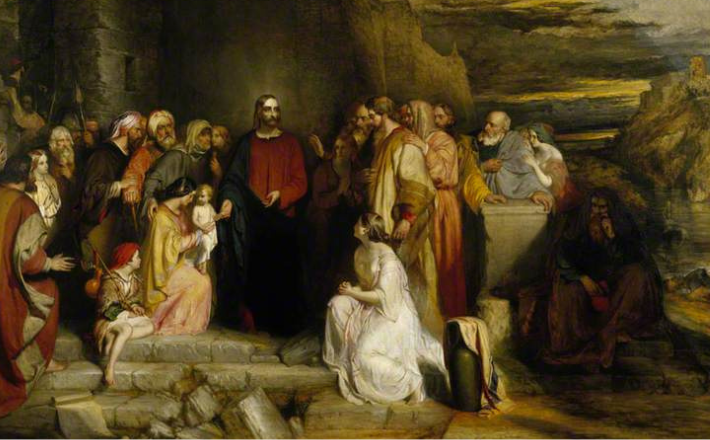Commentary on Joshua 3:7-17
This summer I waded across a short stretch of the Rio Chama in the depths of a canyon the river had carved in the New Mexico desert. There seven of us celebrated a river baptism and shared communion on a sandbar in the brisk morning air. That night the words of a spiritual came to mind, unbidden: “Jordan’s River is chilly and cold, chills the body but not the soul.” That was my experience of the Chama as well, and I began to reflect more deeply about rivers and rituals and the experience of the Israelites who follow Joshua out of the desert.
These pilgrims face a crucial moment of transition. The only leader they had known, Moses, has died. They are not yet sure that God will be present with Joshua to the same degree. They do not know whether they can claim the land God promised. A generation of desert wanderers fed on manna, they do not know how to build homes or eat from the produce of the land (5:12). More immediately, they do not know how they will cross the Jordan, leaving behind old lives for new.
These uncertainties emphasize that the book of Joshua tells the story of transitions: changes of leadership, of geography, of culture, and of vocation. The book begins immediately after the account of Moses’ death (Deuteronomy 34:1-12) with God’s command to Joshua to cross over the Jordan River with the Israelites (Joshua 1:1-4). Following God’s instructions (1:1-9), Joshua tells the people they will cross the river in three days (1:10-11). He then sends two spies to survey the land. They find shelter in the house of Rahab, who helps them escape over the city wall in exchange for a promise they will spare her family when they take the city (2:1-21). After hiding for three days, the spies return and report to Joshua (2:22-24). The next day, the Israelites march to the Jordan, where Joshua gives the Levitical priests and the people directions for crossing the river (3:1-6).
God then speaks to Joshua (3:7-8), telling him the crossing will assure the people God is with him, fulfilling God’s earlier promise (1:5). The priests are to enter the river carrying the ark, the rectangular box containing the two tablets of God’s covenant with Israel. They are to stand in the riverbed with the ark, the visible symbol of God’s presence, and the people will then cross over.
Joshua next addresses the Israelites, describing both the result of the crossing (3:10) and the process (3:11-13). This demonstration of God’s power will prove that God, the Living One, is in their midst and that God will remove the people of the land (3:10). The symbolic choice of seven names to describe these groups emphasizes both the ethnic diversity of the land and the totality of the removal. Joshua stresses the universal sovereignty of Israel’s God: the ark of the covenant of “the Lord of all the earth” or “all the land” will pass before them (3:11).
Joshua explains that when the soles of the feet of the priests carrying the ark rest in the water, the river will break off, standing in a single heap, just as the water of the Sea of Reeds had done for their parents whom God led out of Egypt (Exodus 15:8; Psalm 78:13; Psalm 114:3). These two crossings bookend the journey from slavery to freedom and join the two generations in a shared experience of liberation.
After receiving Joshua’s words, the people cross the Jordan (3:14). As the priests’ feet touch the water’s edge, the river rises in a heap and stands upstream (3:15), just as Joshua had said. The priests stand immobile in the riverbed until all the people cross (3:8, 13, 15, 17; 4:9-10). Later, the Israelites remember the crossing by erecting memorial stones and by retelling the story of their experience (4:19-24). They create a recurring ritual that recalls this crossing and interprets it for future generations.
The Israelites’ transition encompasses leadership, geography, culture, and vocation. Whether our transitions mirror theirs or reflect others—marriage, parenthood, mid-life, divorce, illness, retirement, or bereavement—ritual can strengthen our lives, providing links between chapters of our pilgrimage. The crossing of the Jordan highlights several ways that effective rituals sustain our faith in God’s power and providence.
- Ritual grounds us in the foundational story of God’s delivering love. For the Israelites, that story was the miracle of passing through the waters of the sea and escaping slavery. Crossing over the Jordan re-enacts that foundational deliverance. Christians extend the story of the freedom of that first Passover in narrating the life, death, and resurrection of Jesus through baptism and communion.
- Ritual connects us through time and space with all those who share the experience. Crossing the Jordan joined the Israelites with their parents who crossed the Sea of Reeds, and their memorial stones linked them to future generations. For Christians, baptism incorporates us into the great cloud of witnesses who surround us when we break bread and share the cup. As a result, ritual reminds us we are not alone. Transitions may take us away from our old lives and connections, but ritual joins us to a new community of fellow pilgrims. Our journey is not a solitary one.
- Ritual uses symbols to mark the promise of God’s presence in a relationship of covenantal love. Symbols make God’s steadfast love and faithfulness concrete and tangible. For the Israelites, the ark of the covenant marked God’s presence. In Christian worship, both baptism and communion remind us of God’s presence in our lives as God’s covenant people.
Choosing this text as a focal passage for today’s sermon allows preachers to craft a service of worship to support those who face times of change. Such worship will use the power of ritual and symbol to strengthen trust in God’s providential care in moments of transition, grounding new patterns of life in the foundational narratives of God’s liberating love and grace.



November 5, 2023